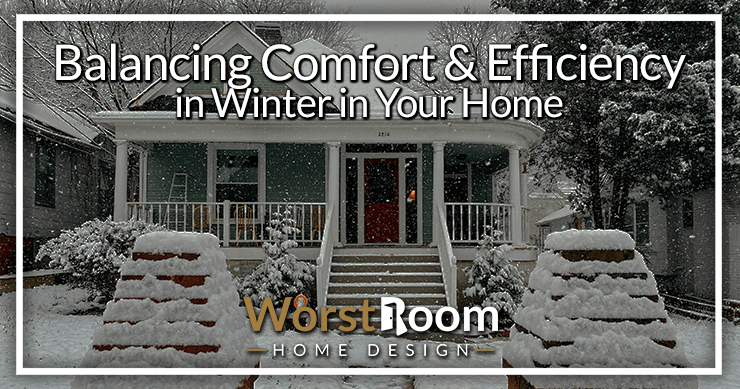Balancing Comfort & Efficiency in Winter in Your Home
Author: Omar Alonso | Editor: Omar Alonso
Review & Research: Jen Worst & Chris Miller

Winter always brings an uncomfortable cold, compelling households across hemispheres to rethink their heating strategies. To hunker down in warmth is instinctual; however, warming your residence can be synonymous with draining your wallet.
As the temperature plummets, there's a real tension between maintaining comfort and managing utility expenses. Yet, striking this balance is vital for enduring the season with ease and economic sense.
Understanding Heat Dynamics

First, one must grasp the fundamentals of how heat behaves. Warm air rises, naturally escaping through ceilings and thin roofs. Drafty windows and under-insulated walls often become prime culprits in heat leakage, turning homes into refrigerators.
Combatting this begins with having structure and infrastructure that deter these tendencies, effectively capturing warmth where it's needed most. Implementing simple measures such as door draft stoppers and window insulation film immediately upholds a more hospitable interior.
Beyond the basics of insulating, it's also important to ensure consistent airflow throughout your home. Simple actions like using ceiling fans in reverse mode can distribute warm air that collects near ceilings.
This recirculation of air aids in maintaining an even temperature, ensuring no pocket of cold air saps your home's coziness. Additionally, shutting interior doors when the heating is on allows each room to retain the warmth it generates, maximizing the overall effect of heating efforts.
When considering various heating strategies, especially with an eye on cost, it may be useful to explore the best electricity plans in Texas. Tailoring a plan that complements your heating needs, local climate, and lifestyle can contribute significantly to an efficient and affordable heating strategy.
Layering & Zoning for Maximum Warmth

Layered dressing is not just a fashion prerogative; it’s a survival tactic against biting cold. Indoors, layering clothes can mitigate reliance on heaters. Meanwhile, zoning a property’s heating system ensures resources are directed to areas in active use rather than wasted on unoccupied rooms.
In the coldest months, concentrating heat in primary living spaces while shutting off others aids both comfort and budget management. For enhanced zoning, consider the addition of thick curtains or room dividers acting as thermal buffers in open-plan spaces. Space heaters can reduce overall energy usage in these cases.
Creating micro-environments where heat is trapped contributes immensely to a welcoming ambiance. This setup isn't static; adjust layouts and barriers as the temperature fluctuates to maintain optimal comfort throughout the entire house.
Economic & Ecological Sensibilities
Environmental consciousness has shifted reliance from fossil fuel-reliant heating methods to more sustainable solutions. Strategies such as using ground-source pumps or photovoltaic systems, though capital-intensive initially, can yield long-term benefits in energy savings and carbon footprint reduction.
Lesser known but equally effective methods can be as simple as stocking a forest’s worth of timber for fireplace usage or harnessing sunlight in extensive daytime hours through strategically placed windows.
Transitioning to newer, more sustainable heating methods often involves a learning curve. Homeowners may discover refreshing advantages such as greater control over their household's energy mix, leading to personalized and cost-effective heating solutions. Embracing change allows for an embrace of new possibilities that contribute to a greener planet.
Technological Innovation in Heating

The advent of programmable thermostats allows for pinpoint regulation of home temperatures, adapting to when a household is active or dormant. This means waking up in a pre-warmed room or returning to a cozy environment after work without heating a lifeless space.
Such advancements showcase the potential to manage the home environment smartly, minimizing energy expenditure while maximizing warmth when it peaks in demand. Some of the latest technologies also enable remote access, allowing you to adjust temperatures from your smartphone even when you're away.
This flexibility empowers users to customize heating schedules to suit ever-changing daily routines. Additionally, occupancy sensors can automatically adjust heat levels based on room usage, ensuring that no cul-de-sac is left unnecessarily warm.
Staying Mindful About Energy Usage
While past approaches focused heavily on brute heat generation, contemporary measures pivot towards mindfulness. Being deliberate about lighting, appliance usage, and even culinary methods can compound savings and well-being significantly.
Accumulating small victories in energy savings cultivates a culture of sustainability and resourcefulness found wanting in generations past. Every degree upon the thermostat contributes towards either moderation or excess.
Such mindfulness extends to regular maintenance of heating systems, ensuring they're running efficiently. Scheduled tune-ups prevent sudden and costly emergencies.
Moreover, they can significantly improve the lifespan of appliances, rewarding proactive behavior with fewer replacements over time. Celebrating these small attentions to detail might just unravel the secret recipe for warmth without waste.
Winter Won't Interfere With Your Comfort
Winter needn’t be a season where frigid nature ensnares our comfort or economic prudence. With attention to detail and a strategic approach, one can live through it graciously, feeling the warmth of not only a well-insulated dwelling but also an intelligently managed home.
In this tug-of-war where balance is the prize, comfort, and cost can indeed become allies rather than adversaries. Winter may bite, but preparation ensures it won’t sting.



